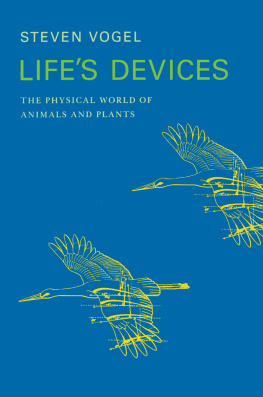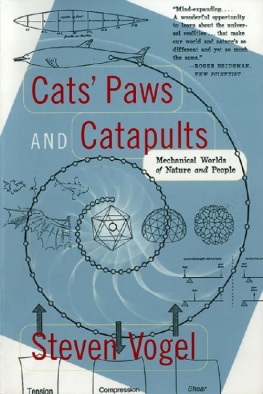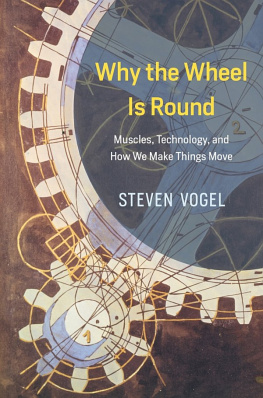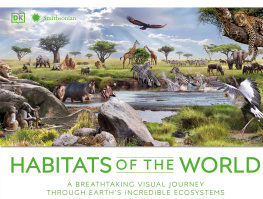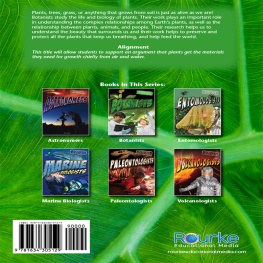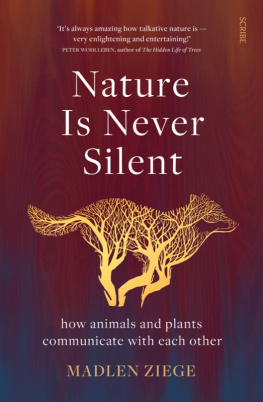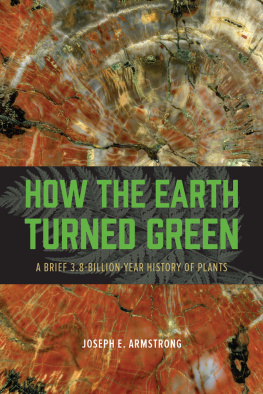LIFES DEVICES
STEVEN VOGEL
Lifes Devices
THE PHYSICAL WORLD OF
ANIMALS AND PLANTS
ILLUSTRATED BY
ROSEMARY ANNE CALVERT
PRINCETON UNIVERSITY PRESS
PRINCETON, N.J.
Copyright 1988 by Princeton University Press
Published by Princeton University Press, 41 William Street, Princeton, New Jersey 08540
In the United Kingdom: Princeton University Press, Chichester, West Sussex
All Rights Reserved
Library of Congress Cataloging-in-Publication Data
Vogel, Steven, 1940
Lifes devices: the physical world of animals and plants / Steven Vogel; illustrated by Rosemary Anne Calvert.
p. cm.
Bibliography: p.
Includes index.
ISBN 0691085048 (alk. paper) ISBN 0691024189 (pbk.)
eISBN: 978-0-691-20949-4 (eBook)
1. Biophysics. 2. Biomechanics. I. Title.
QH505.V634 1988
574.191dcl9 8817603
R0
To my father, Max Vogel,
with great affection and gratitude,
on the occasion of
his seventy-fifth birthday
Contents
ix
Putting up with the everyday world; physical fitness and the designs of evolution; falling for organisms of varying size; natures technology and ours; an obtuse look at right angles
The quantities well need, with their dimensions and units; the moving experience and how to force matters; conservation laws applied to our capillaries and collisions
How a bacterium exceeds a whale; why an ant might bite but cant hit; big is bony and voluminous, small is brainy and edgy; why starfish might be five-armed and why mollusks are just cones
Good words for guesswork; comparisons of corpulence; a speed limit for a swimming duck also tells when to run and not walk; steepness of stimuli, speed changes, and skin temperature; adding up indiscrete items from forces to flows
Matters of state and stress; fish and mosquitoesthe dangers of swimming with air inside and why snorkels must be short; how a tree pulls on a rope of water; when walking on water works but makes waves
Current events near surfaces; troubles for moths that smell; how aquatic worms can raise dirt; doing marine biology in wind tunnels; the gooey world of tiny creatures and why cook with corn syrup; pipes, pressure, and an odd use of blood cells
Pressing flow-induced pressures to practical purposesventilated burrows, reinflated squid, and a beetles unbeatable bubble; streamlined creatures and ones that just go with the flow; making lift and then living with it
A small world in which random movements are a real trip, but where staying put may do just as well; why cells are small and standard, but organisms are vast and varied; plumbing the common features of the pipes within organisms
Making much of a few proteins and sugars; six data each from pulling on teeth, timber, and tendons; keeping the bounce in a tendon and out of an orb web; making short work of cracks in bones or wood; still more on the deforming arts
How not to bend except at joints, and why life is so often hollow; warding off stresses with braces and trusses; why some creatures are stiffened with grit; living balloons from soft stem to stern shark
Why strings must sag, pipes cannot be square, and neither blood vessels nor alveoli can be made of rubber; how tiny worms withstand high pressures and tinier cells higher still; and how the instability of little bubbles keeps air out of trees
Nature as mechanical designerwhat tells her how good is good enough; fine tuning of animals and plants for mountain top or bay bottom; all lifes schemes to keep from being bent out of shape or otherwise to skirt collapse
More moves than merely musclebiological engines behind leaves, antennae, and chromosomes; lifes leverage and transmissionsbones with tendons, and tongues and tentacles; spider hydraulics; why living wheels dont usually work
Why trees, fish, and small sea turtles arent easily upset; lots of ways to stay stuck; size and acceleration from antelope to hydra; the ballistics of micro-gunsstart like a bullet, stay low, and still get nowhere fast
Being hot versus containing heatleaf and camel; saving energy cannot be helped; moving aroundwhat sets the fare and why big travelers get better deals; naming the notions weve been talking about
Preface
How might we begin looking at living things? The ecologist, Marston Bates, once made a suggestion, saying I think Ill start with a rabbit sitting under a raspberry bush and from this gradually go into the mechanics of the situation. This book is about just thatthe mechanics of the situation.
The questions of concern here are enormously diverse, ranging from why trees so rarely fall over and the significance of the hull shape of baby sea turtles to the relative scarcity among organisms of right angles, metals, and wheels. Most of them, though, are exceedingly unsophisticated questions, not the sort that would occur only to a specialist at some frontier of research. Theyre about the ordinary activities of ordinary creaturesquestions a person might pose while exploring a coastline or tramping through a forest. For me much of their appeal rests on just that commonplace character. More immediately, they have the advantage of making no special assumptions about what a reader already knows. Thus the people to whom the present book is directed comprise no well-circumscribed and carefully defined group. Its just me, talking about the things I find interesting, and noticing, in the process, that while the sophistication with which I address questions may have increased with age and experience, the questions themselves are as ingenuous as ever.
What draws these particular questions together is the kind of explanations to which they yield. Neither inheritance nor development nor cellular processes nor molecular events will play much of a role herethe present theater is a simpler one, even if the actors speak a language unfamiliar among biologists. For explanations, rationalizations, and syntheses well look mainly toward geometry and physical science; I want to get a step or so beyond a gee whiz presentation of living things as marvelous contraptions. For a nonbiologist, at least, the approach ought to be a natural one since it invokes notions close to ones everyday experience and intuitive sense of reality. Gravity and elasticity have an immediacy that cells and molecules do not.
Still, decent candor requires that I own up to a slight snag. The bits of physics that play a part here are well-plumbed, well-understood, and not the least bit controversial. They are, furthermore (as a bumper sticker once proclaimed), what makes the world go around. Oddly and unfortunately, theyre not dear to the hearts of all of usfor some theyre items of positive antipathy. Perhaps some social scientist might study the division of society into those superior sorts for whom matters mechanical are rational and those others for whom theyre lurking demons or revealed truth. Education seems to make little difference. By this criterion the auto mechanic has culture while most lawyers remain primitive. The division extends to scientists, with biologists as divided as any, except that most of us were subjected to a few college courses in physics and mathematics, so we cant easily admit either innocence or fear. As James Thurber said about the founding editor of The New Yorker, Ross approached all things mechanical, to reach for a simile, like Henry James approaching Brigitte Bardot. There was awe in it, and embarrassment, and helplessness.

